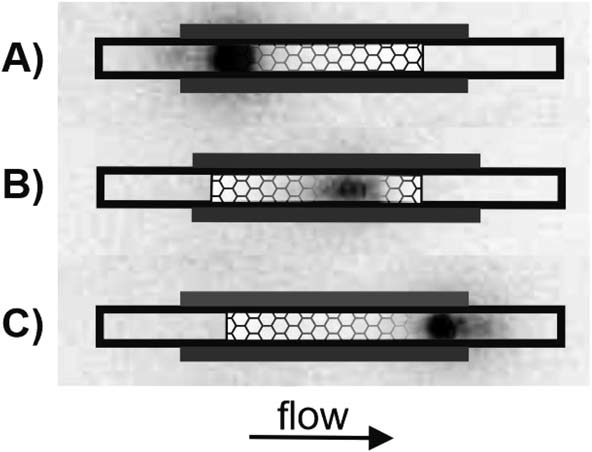Research
RADIOACTIVE INDICATORS – USEFUL TOOLS FOR METHOD DEVELOPMENT
Radiometric measurements of appropriate radiotracers play a key role in our experiments and are typically employed to verify either the VSG efficiency or preconcentration (trapping and volatilization) efficiency of studied analytes independently of used atomic spectrometry method and also to investigate the spatial distribution of the retained analyte in the apparatus as well as to estimate the trapping capacity of the system. Appropriate γ-emitting radioactive indicators (radiotracers) of individual analytes with high specific activity are purchased from commercial suppliers (e.g. Lacomed, s. r. o.) or produced by nuclear reactions with neutrons and/or charged particles, respectively. Radioactive indicators are chemically separated and isolated into the form of the highest attainable specific activity.

Our laboratory is fully authorized (SÚJB permission no. 249351) for handling of open sources of radiation, namely 51Cr, 54Mn, 56, 57Ni, 58Co, 59Fe, 65Zn, 73, 74As, 75Se, 111Ag, 115Cd, 125Sb, 198, 199Au, 203Hg, 205, 206, 207Bi and 212Pb isotopes, as well as of nuclear material, namely thorium and depleted, natural and enriched uranium. To perform nuclear reactions with neutrons and charged particles, respectively, we have an access to LWR-15 nuclear reactor (Nuclear Research Institute Řež, plc, Řež near Prague, Czech Republic) and to charged particle accelerator (U 120 M cyclotron at Nuclear Physics Institute of the CAS, Řež near Prague, Czech Republic). Our department is equipped with a gamma ray spectrometer (Genie 2000, Canberra) with a semiconductor detector HPGe. The proposed system enables evaluation of the measured spectra in connection with separation and purification of the prepared radiotracers. For the high efficiency gamma ray detection we have an access (in co-operation with Institute of Physiology of the CAS, v. v. i., Department of Radiometry) to an auto-gamma counter Wizard 3 (Perkin-Elmer) equipped with a scintillation NaI(Tl) well-type detector. To obtain qualitative information on the spatial distribution of radioactive indicators in the apparatus, the advanced image plate autoradiography is used since it exhibits significantly better performance than the conventional approach utilizing the photosensitive film. We possess the imaging plate (Raytest GmbH, Germany) to record images and we can use, in co-operation with Institute of Microbiology of the CAS, Laboratory of Bioinformatics, a compatible model of a laser scanner (Bio-Rad Molecular Imager FX Fluorescence Laser Scanner) to measure phosphorescence induced by radioactivity present in the sample (see Fig. 1).
Recent papers employing radiotracers for method development
- [1] MUSIL S., KRATZER J., VOBECKÝ M., HOVORKA J., BENADA O., MATOUŠEK T.: Chemical vapor generation of silver for atomic absorption spectrometry with the multiatomizer: radiotracer efficiency study and characterization of silver species. Spectrochimica Acta Part B: Atomic Spectroscopy, 64 (2009), 1240–1247.
- [2] KRATZER J., VOBECKÝ, M., DĚDINA J.: Stibine and bismuthine trapping in quartz tube atomizers for atomic absorption spectrometry. Part 2: a radiotracer study. J. Anal. Atom. Spectrom. 24 (2009), 1222-1228.
- [3] MUSIL S., KRATZER J., VOBECKÝ M., BENADA O., MATOUŠEK, T.: Silver chemical vapor generation for atomic absorption spectrometry: minimization of transport losses, interferences and application to water analysis. Journal of Analytical Atomic Spectrometry, 25 (2010), 1618–1626.
- [4] ARSLAN Y., MATOUŠEK T., KRATZER J., MUSIL S., BENADA O., VOBECKÝ M., ATAMAN O. Y., DĚDINA J.: Gold volatile compound generation: optimization, efficiency and characterization of the generated form. Journal of Analytical Atomic Spectrometry, 26 (2011), 828–837.
- [5] MUSIL S., KRATZER J., VOBECKÝ M., MATOUŠEK, T.: In situ collection of volatile silver species in a new modular quartz tube atomizer for atomic absorption spectrometry. Journal of Analytical Atomic Spectrometry, 27 (2012), 1382–1390.
- [6] HRANÍČEK J., ČERVENÝ V., KRATZER J., VOBECKÝ M., RYCHLOVSKÝ P.: Characterization and mutual comparison of new electrolytic cell designs for hydride generation-atomic absorption spectrometry with quartz tube atomizer using Se as a model analyte and 75Se as a radioactive indicator. Journal of Analytical Atomic Spectrometry, 27 (2012), 1761-1771.
- [7] KRATZER J., MUSIL S., VOBECKÝ M., DĚDINA J.: Hydride generation - in-atomizer collection of Pb in quartz tube atomizers for atomic absorption spectrometry – a 212Pb radiotracer study. Journal of Analytical Atomic Spectrometry, 28 (2013), 344-353.
- [8] SVOBODA M., KRATZER J., VOBECKÝ M., DĚDINA J.: A miniaturized cryogenic trap design for collection of arsanes. Spectrochimica Acta Part B: Atomic Spectroscopy 111 (2015), 46-51.
- [9] RYBÍNOVÁ M., MUSIL S., ČERVENÝ V., VOBECKÝ M., RYCHLOVSKÝ P.: UV-photochemical vapor generation of selenium for atomic absorption spectrometry: Optimization and 75Se radiotracer efficiency study. Spectrochimica Acta Part B: Atomic Spectroscopy, 123 (2016), 134–142.
- [10] KRATZER J., MUSIL S., MARSCHNER, K., SVOBODA M., STURGEON R., MESTER Z., DĚDINA J.: Behavior of selenium hydride in heated quartz tube and dielectric barrier discharge atomizers. Analytica Chimica Acta 1028 (2018), 11-21.
- [11] KRATZER J., MUSIL S., DĚDINA J.: Feasibility of in-situ trapping of selenium hydride in a DBD atomizer for ultrasensitive Se determination by atomic absorption spectrometry studied with 75Se radioactive indicator. J. Anal. Atom. Spectrom., 34 (2019), 193-202.
- [12] MACHADO I., VANĚK D., MUSIL S., PISTÓN M., DĚDINA J., KRATZER J.: Modular design of the trap-and-atomizer device with gold absorber for selenium collection after hydride generation. Journal of Analytical Atomic Spectrometry, 35 (2020), 107–116.
- [13] OLIVEIRA A. F., SVOBODA M., MUSIL S., MACHADO I., VANĚK D., MATOUŠEK T., DĚDINA J., KRATZER J.: Selenium preconcentration in a gold “amalgamator” after hydride generation for atomic spectrometry. Journal of Analytical Atomic Spectrometry 35 (2020), 2132–2141.


